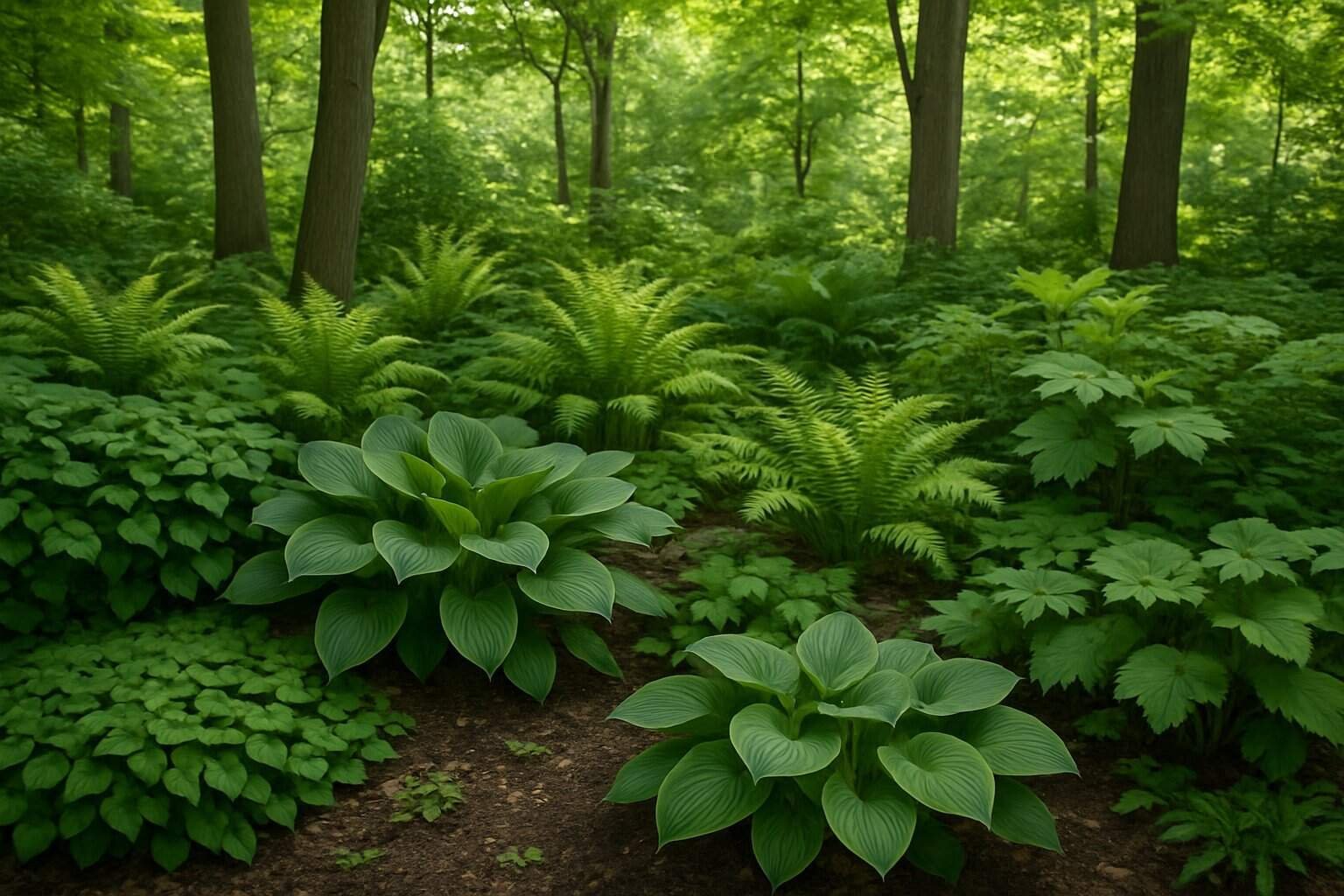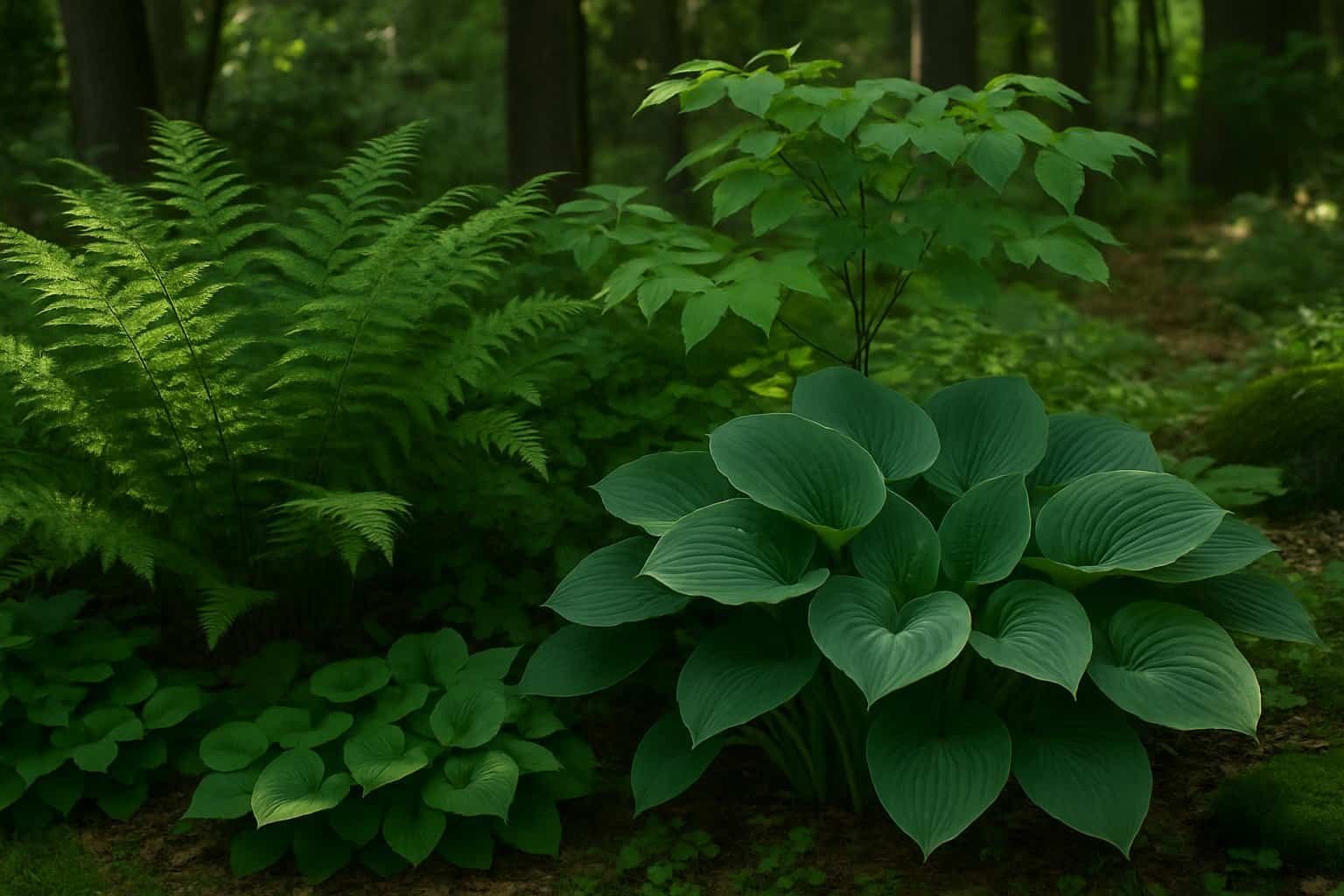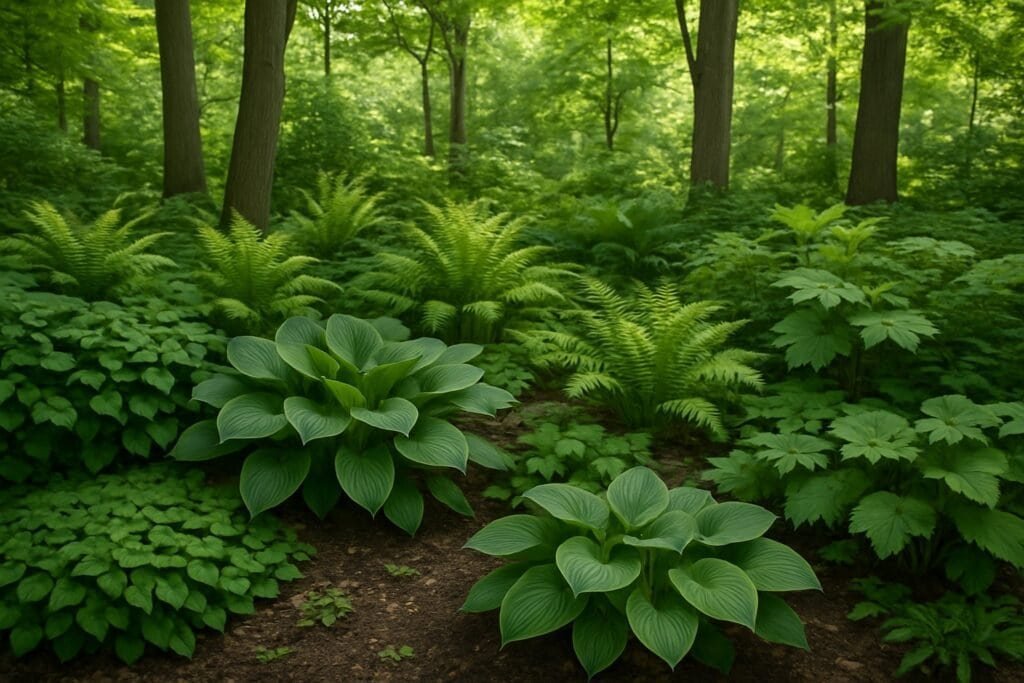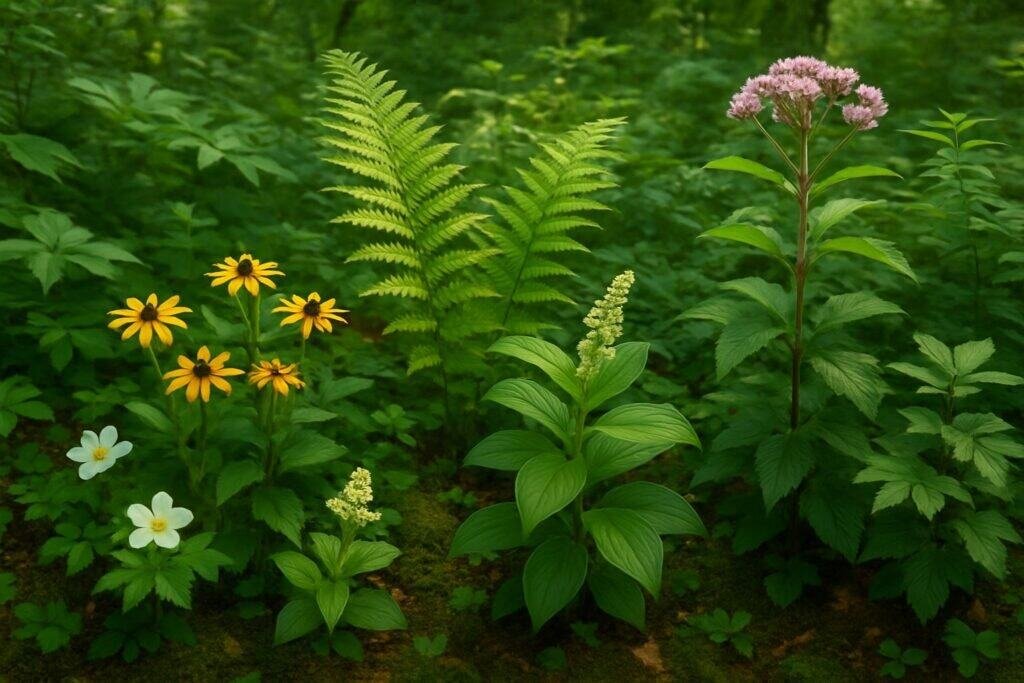Looking for ways to transform shady spots in your garden into vibrant, thriving spaces? Native shade plants offer the perfect solution.
These plants have evolved over thousands of years to flourish in dappled light under tree canopies and other low-light areas.

Native shade plants need less maintenance, conserve water, and provide essential habitat for local wildlife. Unlike non-native alternatives, these plants have natural defenses against regional pests and diseases.
They also adapt well to local soil conditions and rainfall patterns. Shade gardens with native plants create peaceful retreats that showcase nature’s diversity.
From delicate woodland wildflowers to lush ferns and sturdy shrubs, you can find a native shade plant for every garden style and condition.
Key Takeaways
- Native shade plants thrive in low-light conditions and support local ecosystems.
- Different types of shade (dappled, partial, full) determine which native plants will grow best in specific areas.
- Creating a shade garden with native plants requires minimal maintenance and provides year-round visual interest.
Understanding Native Shade Plants
Native shade plants evolved over thousands of years to thrive in low-light conditions specific to their regions. These plants offer ecological benefits and create beautiful, sustainable garden spaces.
Defining Native Shade Plants
Native shade plants naturally occur in a specific geographic region and have adapted to grow in areas with limited sunlight. These plants evolved alongside local wildlife, developing mutual relationships.
Native shade-loving plants vary widely across regions. In the eastern United States, woodland natives like ferns, trillium, and Virginia bluebells thrive under tree canopies.
Western regions might feature different shade-tolerant species like inside-out flower or Pacific bleeding heart. Some plants tolerate part shade (3-6 hours of sun), while others prefer deep shade (less than 3 hours of filtered light).
Understanding your garden’s shade patterns helps you select appropriate native plants.
Benefits of Native Species in Shaded Areas
Native shade plants need much less maintenance once established. They adapt to local soil, rainfall, and temperature, so you rarely need fertilizers or extra watering.
These plants provide crucial habitat and food for local wildlife. Native shade gardens support pollinators, birds, and insects that depend on these plants.
Using native plants in shade gardens improves soil health. Their root systems prevent erosion and add organic matter to the soil.
Native shade plants often resist local pests and diseases better than non-native alternatives. You use fewer chemicals in your garden when you plant natives.
How Shade Influences Plant Selection
Shade comes in different intensities, from dappled light to deep shade. Understanding your conditions is essential for successful plant selection.
- Dappled shade: Filtered light through tree canopies
- Part shade: 3-6 hours of direct sun daily
- Full shade: Less than 3 hours of direct sunlight
- Deep shade: Little to no direct sunlight
Soil moisture varies in shaded areas. Some spots stay damp, while others might be dry, especially under large trees.
Match plants to both light and moisture conditions for best results. Seasonal changes in shade patterns matter too.
Deciduous trees create different light conditions throughout the year, allowing for spring wildflowers to bloom before the canopy fills in.
Types of Shade and Lighting Conditions

Understanding shade conditions helps you select the right native plants for your garden. Light levels vary greatly, so knowing your landscape’s shade type ensures your plants thrive.
Full Shade vs. Partial Shade
Full shade areas get less than 3 hours of direct sunlight daily. You often find these spots on the north side of buildings or under dense trees.
In full shade, sunlight is minimal, creating cool, sometimes moist conditions. Partial shade locations get 3-6 hours of direct sunlight, usually in the morning or late afternoon.
These areas provide more light than full shade but still protect from intense midday sun. Many woodland natives like ferns and wild ginger thrive in full shade.
Plants like woodland phlox and some native sedges prefer partial shade. Light intensity also changes by season.
Winter sun reaches deeper into shaded areas when trees lose their leaves, giving plants a seasonal boost.
Dappled Shade and Partial Sun
Dappled shade occurs under trees with light-filtering canopies. Sunlight filters through leaves, creating shifting patterns of light and shadow.
This mimics natural woodland edges where many native plants evolved. Partial sun areas receive 4-6 hours of direct sunlight but are shaded the rest of the day.
Partial sun spots typically get stronger, more direct midday light. Many native understory plants like woodland asters and bleeding heart have adapted to dappled conditions.
These plants can photosynthesize efficiently even with intermittent light.
Dappled environments offer unique benefits:
- Protection from harsh sun
- Moderate soil moisture retention
- Natural cooling effect
- Reduced wind exposure
Adapting to Different Light Levels
Plants adapt in remarkable ways to different light conditions. Shade-loving natives often have larger, thinner leaves to capture more light.
Their leaves may also contain more chlorophyll, making them appear deeper green. When placing plants, observe how light changes throughout the day and seasons.
A spot that’s shaded in summer might get full sun in winter when trees lose their leaves.
Light measurement tips:
- Use a light meter for precise readings
- Track sunlight patterns across seasons
- Note morning vs. afternoon exposure
Some plants tolerate slightly different conditions than their preference. Many woodland edge species can grow in both partial shade and partial sun if you care for them during establishment.
Consider microclimates within your garden. Reflective surfaces like walls or water features can increase light in shaded areas.
Key Native Shade Plant Varieties

Native shade plants offer many options for gardeners with less sunny spaces. These plants thrive in woodland conditions and provide beautiful, low-maintenance alternatives to non-native species.
Flowering Plants for Shade
Several native flowering plants add color and texture to shady gardens. Virginia bluebells (Mertensia virginica) produce clusters of blue flowers in early spring before going dormant in summer.
They grow 1-2 feet tall and prefer moist, rich soil. Wild ginger (Asarum canadense) forms an excellent groundcover with heart-shaped leaves and unusual maroon flowers that hide beneath the foliage.
It spreads slowly by rhizomes and reaches only 6-8 inches tall. Woodland phlox (Phlox divaricata) displays fragrant lavender-blue flowers in spring on 12-15 inch stems.
It’s semi-evergreen and attracts butterflies. Foamflower (Tiarella cordifolia) produces delicate white flower spikes above maple-shaped leaves.
It’s deer-resistant and blooms for several weeks in spring.
Ferns and Their Role in Shade Gardens
Native ferns provide elegant, feathery textures in shade gardens. They filter light, retain moisture, and create microhabitats for small creatures.
Christmas fern (Polystichum acrostichoides) remains evergreen year-round with dark green fronds reaching 1-2 feet tall. It tolerates dry shade once established.
Maidenhair fern (Adiantum pedatum) has unique fan-shaped fronds on black stems, growing 1-2 feet tall. It prefers rich, moist soil and creates a delicate look.
Cinnamon fern (Osmundastrum cinnamomeum) produces cinnamon-colored fertile fronds among its large green fronds. It can reach 3-5 feet tall and thrives in wet areas.
Native ferns need little maintenance and provide year-round interest.
Sedges and Grasses for Shady Sites
Native sedges and grasses bring movement and structure to shade gardens. Pennsylvania sedge (Carex pensylvanica) forms soft, fine mounds 8-10 inches tall.
It’s drought-tolerant once established and makes a good lawn alternative. Bottlebrush grass (Elymus hystrix) displays seed heads resembling bottlebrushes on 3-5 foot stems.
It provides winter interest and self-seeds gently. River oats (Chasmanthium latifolium) offers flat seedheads that dance in the breeze.
Growing 2-3 feet tall, it tolerates medium shade and various soils. These plants support native insects and birds while controlling erosion on shady slopes.
They require minimal care—just cut back in late winter before new growth appears.
Woodland Wildflowers
Native woodland wildflowers bloom early before trees leaf out. Bloodroot (Sanguinaria canadensis) produces striking white flowers with yellow centers in early spring.
Each bloom emerges wrapped in a unique lobed leaf. Jack-in-the-pulpit (Arisaema triphyllum) features hooded flowers followed by bright red berries in fall.
The plant grows from corms and reaches 1-2 feet tall. Trillium species display three-petaled flowers above whorls of three leaves.
Great white trillium (Trillium grandiflorum) shows large white blooms that age to pink. Wild columbine (Aquilegia canadensis) produces nodding red and yellow flowers that attract hummingbirds.
It self-seeds gently and adapts to many light conditions. These wildflowers often go dormant in summer, so plant them with ferns or sedges for year-round interest.
Featured Native Shade Plant Profiles
Virginia Bluebells
Virginia bluebells (Mertensia virginica) create a stunning spring display with clusters of nodding, bell-shaped flowers. These woodland plants emerge early with pink buds that open to sky-blue flowers.
They grow 1-2 feet tall and spread through slow-moving rhizomes. Virginia bluebells prefer rich, moist soil in partial to full shade.
This plant goes dormant by mid-summer after setting seed. Plant them with later-emerging perennials like ferns or hostas to fill the space.
Butterflies and early bees love their nectar-rich blooms. They pair well with other spring ephemerals like trillium and bloodroot for a woodland garden display.
Wild Ginger
Wild ginger (Asarum canadense) forms a dense groundcover with heart-shaped, glossy green leaves. This native plant is valued for its foliage and growth habit.
It produces maroon flowers at ground level in spring, often hidden beneath the leaves. These flowers attract small pollinating insects and ants.
Wild ginger spreads slowly by rhizomes, reaching 6-12 inches tall. It thrives in moist, humus-rich soil and deep shade.
Benefits of Wild Ginger:
- Deer and rabbit resistant
- Erosion control on slopes
- Attractive groundcover year-round
- Low maintenance once established
Plant wild ginger near woodland phlox or ferns for contrasting textures in shady areas.
Foamflower and Coral Bells
Foamflower (Tiarella cordifolia) and coral bells (Heuchera species) are related native plants with different visual appeals. Foamflower produces delicate white flower spikes that resemble foam above maple-like leaves.
Coral bells offer colorful foliage ranging from purple to amber, silver, and green. Their tiny bell-shaped flowers appear on tall stems above the leaf mounds.
Both plants prefer partial shade and well-drained soil with moderate moisture. They form clumps 12-18 inches tall and wide.
These plants attract hummingbirds and small pollinators. They resist deer browsing and provide interest across multiple seasons.
Use them as border plants along woodland paths or as accent plants among ferns and hostas.
Solomon’s Seal and Mayapple
Solomon’s seal (Polygonatum biflorum) features elegant arching stems with dangling white bell-shaped flowers. The stems grow 1-3 feet tall with parallel-veined leaves arranged along the stem.
Mayapple (Podophyllum peltatum) creates umbrella-like colonies with large, lobed leaves. Single white flowers bloom beneath the leaves and develop into yellow “apples” if pollinated.
Both prefer rich, moist soil in partial to full shade. Solomon’s seal spreads gradually by rhizomes, while mayapple forms larger colonies more quickly.
Planting companions:
- Jacob’s ladder
- Christmas fern
- Woodland phlox
- Maidenhair fern
These plants provide important early-season food for pollinators. Their distinctive forms create architectural interest in woodland gardens and naturalized areas.
Designing and Planting a Native Shade Garden
Creating a beautiful shade garden with native plants requires thoughtful planning. Understanding local growing conditions helps native shade plants thrive.
Prepare the site and place plants strategically to mimic natural woodland habitats.
Site Assessment and Preparation
Observe your garden throughout the day to map shaded areas. Note how shade patterns change and identify areas of deep shade versus dappled light.
This information helps you match plants to their ideal growing conditions. Test your soil pH and composition before planting.
Most woodland natives prefer slightly acidic, humus-rich soil. Amend heavy clay soils with compost to improve drainage and add organic matter.
Clear the planting area of competing vegetation, especially invasive species. Leave the leaf litter in place when possible because it provides natural mulch and habitat for beneficial insects.
Create pathways through your shade garden using stepping stones or mulched paths. This prevents soil compaction and allows easy access for maintenance without disturbing plant roots.
Combining Plants for Year-Round Interest
Layer your shade garden to mimic natural forest structure. Place taller shrubs at the back or center, mid-sized perennials in the middle zone, and ground covers at the edges or as underplantings.
Spring Interest:
- Early bloomers: trillium, bloodroot, Virginia bluebells
- Spring ephemerals provide early color before trees leaf out
Summer Texture:
- Ferns, wild ginger, and foamflower offer varied leaf shapes
- Native hydrangeas provide summer blooms in dappled shade
Fall and Winter Appeal:
- Berry-producing shrubs like spicebush
- Plants with interesting bark or persistent seedheads
Group plants with similar water needs together. This creates visual harmony and makes maintenance more efficient.
Encouraging Biodiversity
Native shade gardens support local wildlife. Include host plants for butterfly larvae like native viburnums and serviceberry.
Leave some brush piles and fallen logs in hidden corners of your garden. These provide shelter for beneficial insects, salamanders, and other small wildlife.
Install a small water feature if space allows. Even a simple bird bath brings more wildlife to your shade garden.
Avoid chemical pesticides that harm beneficial insects. Encourage predatory insects and birds for natural pest management.
Plant in drifts or clusters rather than single specimens. This approach mimics natural woodland patterns and provides more substantial habitat value for pollinators and birds.
Care and Maintenance in Shaded Gardens
Proper care helps native shade plants thrive in less sunny conditions. Different plants have specific needs for soil, moisture, and protection from garden problems.
Soil and Moisture Requirements
Native shade plants often grow in forests with rich, organic soil. Add leaf compost or well-rotted mulch to improve soil structure and fertility.
Most shade gardens benefit from a 2-3 inch layer of mulch. This helps retain moisture, prevent weeds, and add nutrients as it breaks down.
Pine needles, shredded leaves, or bark mulch work well. Water deeply but less frequently to encourage strong root growth.
Many native shade plants develop drought tolerance once their roots establish. Check soil moisture by inserting your finger 1-2 inches into the soil—if it feels dry, it’s time to water.
Managing Dry Shade vs. Moist Soil
Dry shade often occurs under mature trees or near buildings. Plants like Pennsylvania sedge, Christmas fern, and wild ginger adapt well to these conditions.
For dry shade areas:
- Water newly planted specimens regularly for the first year
- Apply mulch to retain moisture
- Choose plants labeled as dry shade tolerant
- Consider installing drip irrigation for consistent moisture
Moist soil shade gardens offer more planting options. Ferns, cardinal flower, and Virginia bluebells thrive in these conditions.
Improve drainage in very wet areas by creating raised beds or adding organic matter to prevent root rot.
Pest and Disease Considerations
Shade gardens usually experience fewer pest problems than sunny areas. The cooler, more moderate conditions discourage many common garden pests.
Common shade garden pests:
- Slugs and snails (control with diatomaceous earth or iron phosphate baits)
- Deer (use repellents or choose resistant plants like ferns and hellebores)
- Japanese beetles (hand-pick early in the morning when they’re sluggish)
Fungal diseases can develop in shade gardens due to higher humidity and slower drying. Improve air circulation by properly spacing plants.
Remove and discard (don’t compost) any diseased foliage promptly. Most native shade plants develop good resistance to local pests and diseases once established.
Supporting Wildlife and Pollinators
Native shade plants support local wildlife and create healthy ecosystems. These plants provide food, shelter, and breeding grounds for beneficial creatures.
Attracting Native Butterflies
Native butterflies depend on specific plants for survival. Many butterfly species only lay eggs on certain native plants their caterpillars can eat.
For example, Monarch butterflies rely exclusively on milkweed, while Black Swallowtails prefer members of the carrot family. Planting these native host plants in shady areas creates nurseries for butterfly reproduction.
Excellent shade-tolerant butterfly plants include:
- Eastern Redbud (Cercis canadensis)
- Wild Columbine (Aquilegia canadensis)
- Woodland Phlox (Phlox divaricata)
These plants provide nectar for adult butterflies and food for caterpillars.
Creating Habitat for Pollinators
Pollinators need more than flowers to thrive. They require habitats with diverse resources.
Native bees, butterflies, and other pollinators need places to nest, hibernate, and find shelter from predators. Shade plants with hollow stems, such as Joe-Pye Weed and native elderberry, provide nesting sites for cavity-nesting bees.
Fallen leaves from native trees create overwintering habitat for many pollinators. Leave some fallen leaves in garden beds instead of removing all of them.
Add these elements to your garden to help pollinators:
- Water sources (shallow dishes with stones)
- Brush piles from pruned branches
- Bare soil patches for ground-nesting bees
- Native grasses for butterfly egg-laying
A mix of flowering plants that bloom throughout the seasons ensures pollinators have food sources all year.
Enhancing Local Ecosystems
Native shade plants strengthen local ecosystems by creating food webs that support many species. These plants host specialized insects that become food for birds and other wildlife.
Research shows native oak trees support over 500 species of caterpillars, while non-native trees might support fewer than five species. This difference affects bird populations, as most songbirds feed caterpillars to their young.
Native shade plants also improve soil health through relationships with fungi and microorganisms. These underground networks help cycle nutrients and build soil structure.
By choosing native shade plants, you help preserve genetic diversity within local plant populations. This diversity makes plant communities more resilient to environmental changes and extreme weather.
Frequently Asked Questions
Native shade plants vary by region, with each area offering unique species adapted to local conditions. These plants provide ecological benefits while thriving in less sunny garden spaces.
What are the best native perennials for shaded areas in the Northeast?
Ferns like Christmas Fern and Lady Fern are excellent Northeast natives for shade. They provide year-round texture and require minimal maintenance.
Bleeding Heart (Dicentra eximia) offers heart-shaped pink flowers in spring and early summer. It naturalizes well in woodland gardens and attracts pollinators.
Wild Ginger (Asarum canadense) makes an excellent groundcover with unique kidney-shaped leaves. Its maroon flowers appear at ground level in spring, adding interest beneath shrubs and trees.
Foamflower (Tiarella cordifolia) produces delicate white flower spikes above maple-like foliage. It spreads slowly to form attractive colonies in moist, shaded areas.
Which indigenous wildflowers from Maryland are suited for growth in shaded conditions?
Virginia Bluebells (Mertensia virginica) display striking blue bell-shaped flowers in Maryland’s spring woodlands. They go dormant in summer, so plant with later-emerging species.
Woodland Phlox (Phlox divaricata) creates carpets of lavender-blue flowers in spring. This Maryland native attracts butterflies and grows 8-12 inches tall.
White Wood Aster (Eurybia divaricata) blooms with small white daisy-like flowers in late summer. It tolerates dry shade once established, making it versatile for Maryland landscapes.
How can I identify native shade-tolerant plants for landscape design in Zone 6?
Research local native plant societies and extension offices for Zone 6 shade plant lists. These resources often provide regionally specific information about soil preferences and growth habits.
Look for plants with broad, thin leaves, which typically indicate shade adaptation. These leaf structures maximize light capture in low-light environments.
Visit local woodland preserves in Zone 6 to observe natural plant communities. Notice which species thrive in shaded conditions similar to your landscape.
Consider seasonal changes when identifying natives for design. Some woodland plants bloom early before tree canopies leaf out, while others provide interest in summer or fall.
What native plants from Illinois can effectively grow in dense shade?
Wild Columbine (Aquilegia canadensis) thrives in Illinois woodlands even in deep shade. Its nodding red and yellow flowers attract hummingbirds in spring.
Jacob’s Ladder (Polemonium reptans) features delicate blue flowers above fern-like foliage. This Illinois native prefers rich, moist soils in dense shade.
Solomon’s Seal (Polygonatum biflorum) produces arching stems with dangling white flowers in spring. The blue-black berries that follow provide food for birds in Illinois ecosystems.
Black Cohosh (Actaea racemosa) sends up dramatic white flower spikes in summer. It grows 4-6 feet tall, adding vertical interest to shaded Illinois gardens.
Can you recommend long-blooming native perennials that are ideal for shaded gardens in Pennsylvania?
Great Blue Lobelia (Lobelia siphilitica) produces spikes of blue flowers from July through September. This Pennsylvania native attracts pollinators and grows well in part shade.
Zigzag Goldenrod (Solidago flexicaulis) blooms with bright yellow flowers in late summer through fall. Unlike other goldenrods, it thrives in woodland settings throughout Pennsylvania.
Heartleaf Aster (Symphyotrichum cordifolium) displays purple-blue flowers from August to October. It tolerates dry shade once established and provides late-season color.
Allegheny Spurge (Pachysandra procumbens) offers semi-evergreen foliage and subtle spring flowers. This native pachysandra provides year-round structure in Pennsylvania shade gardens.
Are there any Wisconsin native plants that can survive in full shade environments?
Mayapple (Podophyllum peltatum) creates colonies with umbrella-like leaves in Wisconsin woodlands. Its white flowers bloom beneath the foliage, followed by edible yellow fruits.
Wild Geranium (Geranium maculatum) produces lavender-pink flowers in spring. This Wisconsin native grows well in full shade and adapts to woodland settings.
Northern Maidenhair Fern (Adiantum pedatum) has delicate fronds on black stems. It thrives in heavily shaded areas with consistent moisture.
Baneberry (Actaea species) offers fluffy white flowers followed by bright berries. Both red and white varieties grow in Wisconsin’s shadiest forests.


